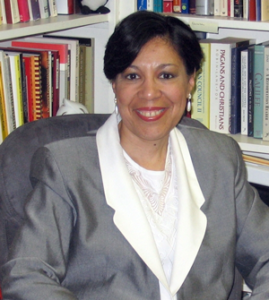
No Hay Peor Ciego: Unlearning to See
When those of the dominant culture express shock and dismay at events such as those that took place in Ferguson, Missouri in 2014, when they claim with indignation that this “should never happen again,” I think of a Puerto Rican proverb: “No hay peor ciego que el que no quiera ver (There is no worse blind person than the one who refuses to see).”
Joseph Barndt observes that in the socialization process of being raced as white, the dominant culture is not only segregated from people of color and their realities, but is intentionally blinded to those realities. Its members become both blind and forgetful of its history. Citing Martin Luther King, Jr., Barndt notes that what is today’s headline news is quickly forgotten.[1] How else to explain the repeated admonitions of “never again”: in response to Rodney King, Vincent Chen, Anthony Báez, Abner Louima, Amadou Diallo, and so many others…only to be confronted with the unnecessary slayings of Michael Brown, Eric Grant, Tamir Rice, and recently, of Walter Scott and Freddie Gray?
Sadly, such cases are not exceptions to a rule but indicators of an endemic structural problem of racism in our justice system. It is a system that allows the continuous daily harassment of people of color en lo cotidiano (in the spaces of the everyday). It is a system that allows the mass incarceration of a disproportionate number of people of color—a reality to which many in the white population seem to be blind. Whiteness is a socialization process that teaches the dominant culture not to see.[2]
This blindness has a direct impact on how we teach about racism in theological education. Beyond the personal and structural effects of privilege and power, we need to consider two additional factors.
First, as bell hooks urged us, to teach students about racism we must also help them to unlearn what they believe they know.[3] We must unravel a lifetime of socialization. As teachers, we too must unlearn our habitus—the practiced behaviors and attitudes we live out en lo cotidiano. This means being brutally honest and incredibly humble with ourselves. It means closing the chasm between the academic platitudes we allegedly espouse and our actual everyday interactions. [4] It means divesting ourselves of the blindness, isolation, and apathy that both allow us to forget the Anthony Báezes and Abner Louimas and allow us to think that Michael Brown or Walter Scott might be an exceptional case.
Second, the institution in which we teach must embody an anti-racist reality. hooks calls racism “white supremacy” to indicate its all-embracing effects in both white communities and communities of color, as well as its societal and structural realities.[5] This permeating reality is what makes it possible for a white person to go through his or her life without ever interacting directly with a person of color. Unless theological institutions intentionally resist this apartheid-like atmosphere, students will covertly, through its null curriculum, and overtly, through daily practices and realities, continue to learn that racist behavior is acceptable.
What does it mean to embody an anti-racist reality? It means an institution examining both the diversity of its student body, but also of its board of trustees, key administrative staff, and faculty.[6] Furthermore, it means critically examining how it treats its support staff (often comprised primarily of people of color). It means examining the core documents that determine where institutional power lies, its curricular offerings, and syllabi. It means repeatedly asking the key question of whose presence and words are valued. All the anti-racist rhetoric and classes will be in vain if the persistent underlying tenor of an institution is that “whiteness is what is valued and normative.”
In many ways, teaching about racism and teaching anti-racist behavior is like the blind leading the blind. It means learning to overcome hundreds of years of an intentional socialization process. It means resisting and deconstructing social structures of power that coerce through social, religious, legal and violent means. Yet, for those of us committed to this work, there is also the acknowledgement that we can do no less if we are to survive and even thrive as a people, and particularly as a people of God.
[1] Joseph Barndt, Understanding and Dismantling Racism: The Twenty-First Century Challenge to White America (MN: Fortress Press, 2007), 134.
[2] Ibid., 88–89.
[3] bell hooks, “Talking Race and Racism,” in Teaching Community: A Pedagogy of Hope (NY: Routledge, 2003), 35–36.
[4] Ibid., 32. Barndt, 130.
[5] hooks, 28.
[6] Critical here is to observe how the lone or few colleagues of color are treated during faculty or board meetings.